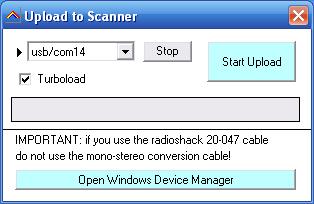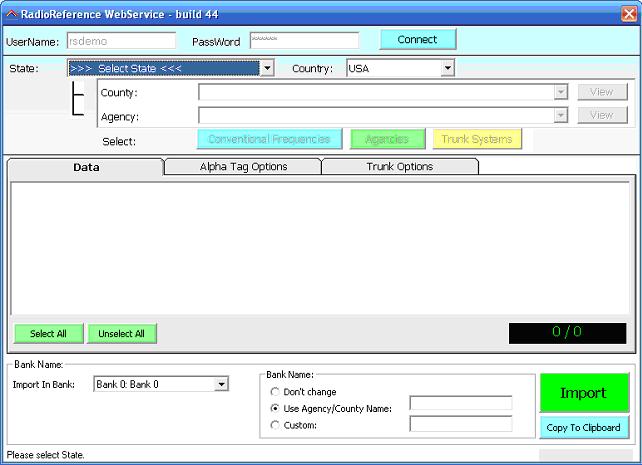Difference between revisions of "ARC500 User Guide"
From The RadioReference Wiki
| Line 102: | Line 102: | ||
---- | ---- | ||
| − | === Adding Individual | + | === Adding Individual Talkgroups === |
| + | |||
| + | 1. Click on Talkgroup in the Object Browser. | ||
| + | |||
| + | 2. Click the +/ADD button in the toolbar. | ||
| + | |||
| + | 3. In the new line enter the talkgroup. | ||
| + | |||
| + | 4. Double click the Trunk Systems cell. The software will show all available trunk systems. | ||
| + | |||
| + | 5. Select the trunk system this new talkgroup belongs to. | ||
| − | |||
---- | ---- | ||
Revision as of 12:43, 29 July 2010
ARC500 software series for Radioshack PRO-106/PRO-197 and GRE PSR500/PSR600
Using ARC500 to populate a scanner
NOTE: Importing from the Radio Reference Database only works if you are a Premium Subscriber to the Radio Reference Web site. The key to unlock the utility for importing systems, TGs, and/or conventional frequencies from the Database is the Premium Subscription.
Driver/Com port setup:
Before the customer can upload data they must plug in the Radioshack 20-546 USB cable and install the driver. The driver can be found on the cdrom that is included with the cable. The cdrom also includes scanner software demo versions. A license for the software can pe purchased at www.radioreference.com/radioshack or call 1-800-SCANNER . The demo versions work for 7 days and also includes a total of two complinatary imports from the Radioreference database. Click here for the Radioshack scanner software manual in PDF format.
USB/Comport check and setup:
After installing the driver the correct COM/USB port must be selected in ARC500 before you can upload data:
- start the ARC500 software for the PRO-106/PRO-197
- enter the freq/talkgroups or import from radioreference.
- in the top menu select SCANNER _ Upload To Scanner
- a new window is shown
- in the drop down box all available usb/com ports are shown. If there is only one usb/com port shown it is most likely the USB cable.
- if there are multiple usb/com ports listed you can open the Windows device manager by clicking the button marked 'Open Windows Device Manager'.
- a new windows opens, locate the section 'ports' and click the + to show all settings.
- locate the item marked 'USB serial Port' and note the COM number.
- This com number must be selected in ARC500
- Now press 'Start Upload'
- The leds at the interface will flash indicating it is receiving data from the software
'Nothing Enabled' error:
If the customer uploaded data and the scanner displays 'Nothing enabled' this indicates that either:
- none of the scanlists (1-20) are enabled. Scanlists can be enabled by pressing the numeric buttons 0-9 (use FUNC + 0-9 for scanlists 11-20). Try pressing the number 1 key on the scanner's key pad to enable the default scanlist 1.
- no objects are assigned to a scanlist. In the PRO-106/197 frequencies/talkgroups must be assigned to a scanlists before they can be scanned. This can be done in ARC500 or during the import process from radioreference. In the RR import window there is a tab called 'scanlists' and this defines the scanlists the objects are linked to during the import process.
Programming mode:
- The software will automatically put the scanner in programming mode. Customer should not put the scanner in program mode by holding the PGM button + power on. That is only used for firmware upgrades.
Toggling Scan Lists
To toggle scan lists off or on, use the number keys on the scanner's keypad. Scan Lists 1 - 10 are toggled by using numbers 1 - 0, and Scan Lists 11 - 20 are toggled by pressing the FUNC key and then a number 1 - 0 (i.e. FUNC + 3 = Scan List 13).
Trunk Systems
Importing Trunked Systems and Talk Groups
1. To Import from Radio Reference in ARC500, click Internet > Radioreference Import
2. On the next page enter your Radioreference Username and Password and then click on "Connect". The software will remember your username and password and next time you open the import window it will automatically connect.
3. Using the drop-down menus, select the State/Province and County. Next press the yellow Trunk Systems button. This will populate the Trunk System drop down list with all the available trunk systems. It now takes some time for the software to collect the data so be patient.
Change country: The default country selection is 'USA'. To change select a new Country from the country drop down menu and click 'Connect'.
4. Click on the "+" signs to expand the Site(s) and TGs available for the selected system placing a check mark for those Sites and TGs you want to import. You must select at least one Site to Import along with the TGs or you will get a "No TSYS Assigned" warning when you begin to scan.
5. In the Scanlists tab you can select the Scanlists. (without this, the TGs will not be assigned a Scan List and when you start to scan you will get a "Nothing Enabled" warning).
6. Click on the green "IMPORT" button (Any site or TG without a check mark will not be imported, so check them over before proceeding.)
WARNING NOTE: The scanner is limited to a total of 32 frequencies for a trunking system. That means that no more than 32 Control Channel frequencies or a combination of Control Channel frequencies and Alternate Control Channel frequencies can be entered per system. If all the frequencies in use on a particular site are entered, that will reduce the number of sites you will be able to enter in that system.
In an EDACS or LTR Standard system, each Site must be programmed as a seperate system. Since all the frequencies must be imported in these types of systems (instead of just a Control Channel as in a Motorola system), and since the frequencies must be in LCN order, frequencies from different sites CANNOT be mixed in the same TSYS frequency list.
NOTE: Check the Radio Reference Database for the system you are importing. Some of the Admins have better descriptions than display attributes. Remember, only 16 characters of either the description or the display attribute in the RR Database are imported. You can always change the alpha tag field yourself, too.
ANOTHER WARNING NOTE: At this point it is good practice to check the Talkgroups that were imported. Make sure the Scan List Map shows numbers indicating the Tgs have been assingned a Scan List. If the TGs are not in a Scan List, you will get a "Nothing Enabled" warning when you begin to scan. The Scan List column in the talkgroup grid is where you can assign each Talkgroups to a Scan List.
8. To upload the data imported from the Radio Reference Database to the scanner, click on Scanner > Upload to Scanner. Check the usb/com port and then press 'START UPLOAD'. The scanner will reboot itself after the upload is finished and then should start scanning automatically after uploading. If not, press SCAN. You might also have to press the number 1 key on the scanner to enable the #1 Scanlist.
9. Click on File (upper left corner) > Save As... and save this information to the ARC500 folder on your computer as yourfilename.gr5
Adding Individual Talkgroups
1. Click on Talkgroup in the Object Browser.
2. Click the +/ADD button in the toolbar.
3. In the new line enter the talkgroup.
4. Double click the Trunk Systems cell. The software will show all available trunk systems.
5. Select the trunk system this new talkgroup belongs to.
Deleting a Trunk System
1. Click on Trunk Systems in the Object Browser.
2. Highlight the System to be deleted.
3. Click on the Delete button in the toolbar
Deleting a Talkgroup
1. Click on Talkgroup in the Object Browser.
2. Highlight the Talkgroup to be deleted.
3. Select Edit and then Delete.
Edit Control Channel Frequencies
To edit the Control Channel frequencies click on the TSYS Objects tab > click on the System Frequencies bar. After rebanding, all that is necessary is editing the CC frequency as long as a custom band plan is programmed into the scanner.
WARNING NOTE: The scanner is limited to a total of 32 frequencies for a trunking system. That means that no more than 32 Control Channel frequencies or a combination of Control Channel frequencies and Alternate Control Channel frequencies can be entered per system. If all the frequencies in use on a particular site are entered, that will reduce the number of sites you will be able to enter in that system.
Custom Band Plan (Trunking Tables)
To edit or set a Custom Band Plan (Trunking Tables), click on the TSYS Objects tab > click on the Trunking Tables bar, and when the next window opens, click the drop-down menu and select the appropriate band plan > click OK. For the 800 MHz trunking systems select 800 MHz Rebanded. This band plan or trunking table will be good for systems already rebanded as well as those not yet rebanded.
Open or Closed Mode?
Open Mode: the scanner will stop on all active talkgroups. To use Open Mode program an '*' character as talkgroup. This is also referred to as a wildcard. ARC500 will by default always add a wildcard talkgroup when you add a new trunk system. Closed Mode: the scanner will only stop at talkgroups programmed in the Talkgroup grid and linked to the selected trunk system.



